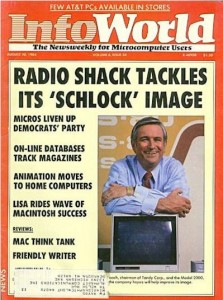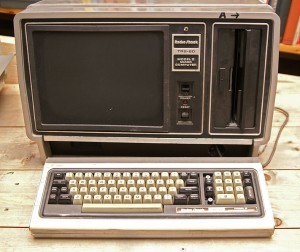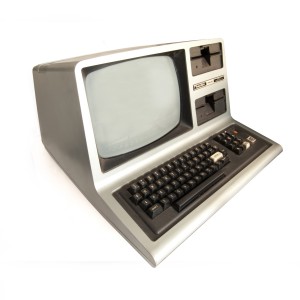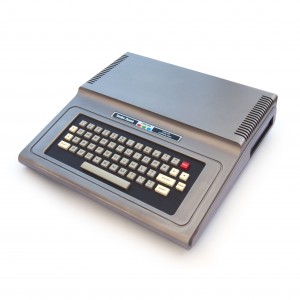The microcomputer landscape of 1980 looked very different than it had when the trinity of 1977 first hit the scene. The hackers and early adopters who first made the TRS-80 a success were a step closer to sane than the solder-iron-wielding crazies who had constructed Altairs in their garages out of a set of diagrams and a loose pile of chips, but only a step. Owning and operating a computer was still expensive and difficult, and the question on the lips of wives and girlfriends across the country — “But what is it really good for?” — did not have any particularly strong answers. By 1980, though, that was changing, sufficiently so in fact that segments of the population were beginning to purchase computers not out of fascination with the technology itself, but rather because of what the technology would allow them to accomplish. That was due to the work of all those early adopters, who hacked like mad to create useful things that would justify their time in the terms that matter most in a market economy, dollars and cents, and thus in turn buy them yet more time to hack.
The most celebrated of these early killer apps today, perhaps due to its having been featured on The Triumph of the Nerds documentary, is VisiCalc, the spreadsheet program whose basic approach is still echoed in the Microsoft Excel we all know and love (?) today. Introduced in late 1979, it gave accountants, small-business owners, and even home users compelling reasons to own a microcomputer — whether to calculate taxes or accounts receivable and payable, or just to keep the checkbook balanced. But there are other examples. The first crude word processing application was called The Electric Pencil; it predated even the trinity of 1977, appearing for the early kit computers in December of 1976. It took WordStar, however, to refine the concept into a program flexible and powerful enough to begin to replace the expensive specialized word-processing machines found on secretary’s desks around the country upon its release in September of 1978. dBase, the first programmable relational database for microcomputers, made its first appearance in 1979. And while they were seldom openly mentioned as a reason to buy these early computers, games were always present as a sort of guilty pleasure and secret motivator. They were still crude and limited in 1980, but growing by leaps and bounds in both ambition and sales as the first specialized entertainment publishers such as Adventure International got off the ground, and as new microcomputers much more suited for play began to appear in the wake of the Atari VCS game-console sensation which began sweeping the country in earnest during the holiday season of 1979.
Ah, yes, the new machines. As new applications showed how useful and/or entertaining computers could be in both businesses and homes and as their sales figures responded, plenty of new players came rushing into the market. Some, such as the Exidy Sorcerer and Texas Instruments 99/4, found little traction, becoming mere historical footnotes and modern collector’s items. Others, though, heralded major new technological and cultural developments. We’ll get to these at some point, but for this post let’s see if we can bring some sort of order — i.e., some categories — to the crazy quilt of microcomputers available by 1980. Oddities like the TI 99/4 (the world’s first 16-bit microcomputer based on a CPU of TI’s own design) aside, most computers were based on one of two 8-bit CPU architectures.
First there was the Intel 8080, the chip at the heart of the original Altair kit computer and its contemporaries, and the Z80, a mostly compatible CPU from Zilog that nevertheless offered a more flexible, efficient design; this, you may recall, was the chip Tandy chose for the TRS-80. Apart from the TRS-80, which for better and (as we shall shortly see) for worse remained largely its own thing, these machines generally ran the first widespread platform-agnostic operating system for microcomputers, CP/M (Control Program for Microcomputers). Developed by Gary Kildall at the very dawn of the microcomputer era and published by his company Digital Research, CP/M was the MS-DOS — or, if you like, the Microsoft Windows — of this early era, a de facto if not official standard that allowed machines from a huge variety of makers to share software and information. (There is also a more tangible link between CP/M and MS-DOS: depending on whom you talk to, the original MS-DOS from 1981 was either “inspired by” CP/M or an outright unauthorized reverse engineering of the earlier O/S. But that subject will doubtlessly come up again in later posts…) For a computer to run CP/M, it required two things: an Intel 8080 or Zilog Z80 CPU, and a certain standard bus design for communicating with its disk drives and other peripherals, known as the S-100 — a design which had its origins as far back as the original Altair.(UPDATE: As Jonno points out in the comments, an S-100 bus was not a strict requirement for CP/M.)
CP/M and the Intel- and Zilog-based architectures on which it ran became the standard environment for “serious” microcomputing of the late 1970s and early 1980s, the kind done in corporate offices and small businesses. WordStar and dBase were both born there, and VisiCalc, although conceived on the Apple II, quickly found its way there. CP/M had, however, no graphics capabilities at all and only limited support for real-time operations, making it problematic as a platform for many types of games and even educational software. It also relied upon the existence of at least one disk drive on its host platform at a time when such devices tended to be very pricy. These factors made CP/M and the 8080 a poor fit for the less expensive, usually cassette-based computers generally chosen by home users. That market was dominated by another hardware architecture, that of the MOS Technologies 6502 CPU.
When the 6502 first appeared in 1975, MOS was a tiny independent chip-maker, but that changed when Commodore purchased the entire company in late 1976. This move, one of the smartest that Commodore head Jack Tramiel ever made, left Commodore in the enviable position of making money not only when it sold its own machines such as the PET, but also every time a rival purchased 6502s for its own products. Said rivals initially included only Apple with its Apple II line and a number of kit-based computers from various small manufacturers, but that would change soon enough.
A CP/M equivalent for 6502-based machines was never developed, meaning that they remained largely incompatible with one another. BASIC did serve as a partial lingua franca, as virtually all of these machines housed a version of Microsoft’s industry-standard BASIC in their ROMs, but there was enough variation from implementation to implementation that most programs needed at least some customizing. And of course when one progressed beyond BASIC to assembly language to take full advantage of everything a 6502-based machine had to offer — especially graphics and sound, which capabilities varied wildly from model to model — one was faced with essentially coding everything from scratch for each machine one wished to support. Crazy times — although with the ever-increasing proliferation of incompatible mobile computing devices in our own times it’s starting to look like 1980 all over again.
What the 6502 world lost in compatibility it gained in flexibility. Freed from the need to work through a comparatively complex and inefficient OS like CP/M, programmers could code right to the metal on these machines, manipulating every element of the hardware directly for maximum efficiency. Further, the 6502-based machines, being generally aimed at the home and education markets, tended to feature the graphics and sound capabilities that were missing from the bland, textual world of CP/M; the Apple II, for instance, was the only member of the trinity of 1977 with support for proper bitmap graphics, a subject I’ll begin to discuss in more detail in my next post.
But now you might be wondering where all of this left the TRS-80, which fit neatly into neither of the two categories just described. Although the TRS-80 was built around the Z80 CPU, Radio Shack had chosen in the name of penny pinching not to implement the S-100 bus design. (UPDATE: As happens from time to time around these parts, this is not correct. Actually, the problem involved the memory map of the original TRS-80, in which ROM preceded RAM; a CP/M machine required the reverse. Thanks to Jonno for pointing this out in the comments.) This made CP/M a nonstarter. Despite being a huge success in its early years and still having the largest installed base of any microcomputer, the TRS-80’s future was, at least in retrospect, already clouded in 1980. Its incompatibility with CP/M left it cut off from the quickly growing base of serious business software found on that OS. In spite of the TRS-80’s relatively cheap price, Radio Shack’s reputation as purveyors of cheap junk for the masses did little to attract business users, and in a classic chicken-or-the-egg scenario this lack of business users discouraged developers from porting their products from CP/M to the little oddball Tandy machine. And in the other half of the microcomputer market, the 6502-dominated world of games machines and hobbyist computing, the TRS-80 was also looking like an increasingly poor fit with its almost complete lack of graphics and absolutely complete lack of sound. The arrival of the Atari 400 and 800, colorful 6502-based machines with superb graphics and sound for the time, and, a bit later in early 1981, the Commodore VIC-20, a much less capable machine in comparison but one nevertheless sporting color graphics and sound for an unprecedentedly low price, were particularly ominous signs.
While the wisdom of many of its moves is debatable, Tandy at least did not stand entirely still in the face of these developments. In fact, it released quite a blizzard of new machines, none of which came close to recapturing the market share the TRS-80 enjoyed in the late 1970s.
Tandy released a new machine called the TRS-80 Model 2 (the original TRS-80 being now retroactively renamed to the Model 1) in late 1979. The Model 2 was designed to capture the business computing market that was passing the Model 1 by; it sold with integrated disk drives and did properly implement the S-100 bus included bank-switchable ROM, thus allowing it to run CP/M. But it was also a much more expensive machine than the Model 1 and, most dismaying of all, completely incompatible with it. Thanks to Radio Shack’s usual lack of marketing acumen and genius for clunky, tacky-looking design as well as its high price, it was not a big success in the business market, while its incompatibility made it of little interest to existing Model 1 owners.
The Model 3 which appeared to replace the Model 1 in the summer of 1980, meanwhile, was rather forced on Radio Shack. The Model 1 had put out so much radio interference that, in an example of the boundless ingenuity that marked the early microcomputer era, people began writing programs to manipulate memory so as to make music using this interference along with a nearby transistor radio to pick it up. New FCC regulations for 1981 forced Radio Shack to build in proper RF shielding, and thus spoiled that particular kind of fun. In addition to fixing this issue, the Model 3 also sported a slightly faster version of the Z80 CPU and (hallelujah!) real lower-case letter support for both input and output amongst other modest improvements. Yet it did nothing to improve the Model 1’s meager display capabilities. And, in the one-step-forward two-steps-back dance that seemed to define Radio Shack, the Model 3 was optimistically said to be just “80%” compatible with the Model 1, while, once again, no S-100 bus meant no the design did not allow for CP/M. Radio Shack in their marketing genius now had three separate machines labeled the TRS-80, each now partially or entirely incompatible with its siblings. Just imagine trying to figure out what software actually worked on your version…
And incredibly, there was yet another completely incompatible TRS-80 released in 1980, this one the most significant of all. Although officially called the TRS-80 Color Computer, it was a radical departure from anything seen before, being built around perhaps the most advanced 8-bit CPU ever produced, the new Motorola 6809E. Like so many Radio Shack systems, it offered intriguing potential bundled together with some dismaying weaknesses. On the plus side were the powerful 6809E itself and an advanced Microsoft BASIC that made it a favorite among hobbyist programmers; on the weak side were sound and graphics capabilities that, while a step up from the other TRS-80 models, were still not competitive with new and upcoming models from companies like Atari and Commodore. In spite of that the CoCos, as they soon became affectionately known, had a long run during which they consistently flew under the radar of the mainstream, attracting little in the way of games or applications from most publishers or even from Radio Shack itself, but survived on the back of a sort of cult industry all their own sustained by a fanatically loyal user base. The CoCo line did not finally go out of production until 1991.
There are many more interesting stories to tell about Radio Shack’s quirky little computers, but none would ever come close to dominating the industry the way that the TRS-80 Model 1 did for those first few years. In truth, even the Model 1 was popular because it was widely available at a time when distribution channels for other brands were barely extant and because its price was reasonable rather than because of any sterling technical qualities of the machine itself. The TRS-80 was really not so far removed from Radio Shack’s other products: it basically got the job done, but in about the most uncool and unsexy way imaginable. It primed the pump of the home computer industry and brought adventure games into the home for the first time, but already in 1980 its time was passing.
So, we’ll bid adieu to the old Trash-80 and move on next time to look at the machine that made the company that has come to define cool and sexy in technology. Yes, I’m talking about those two plucky kids in that California garage.













